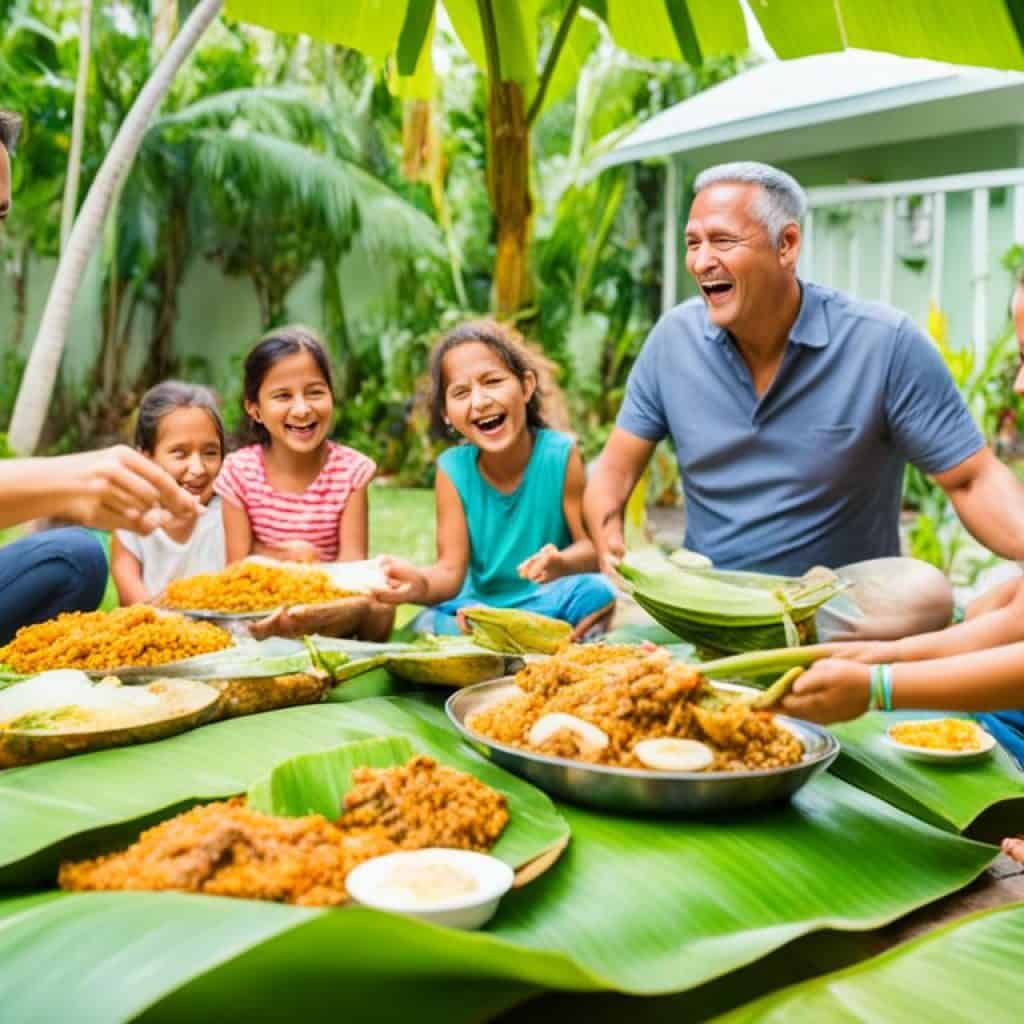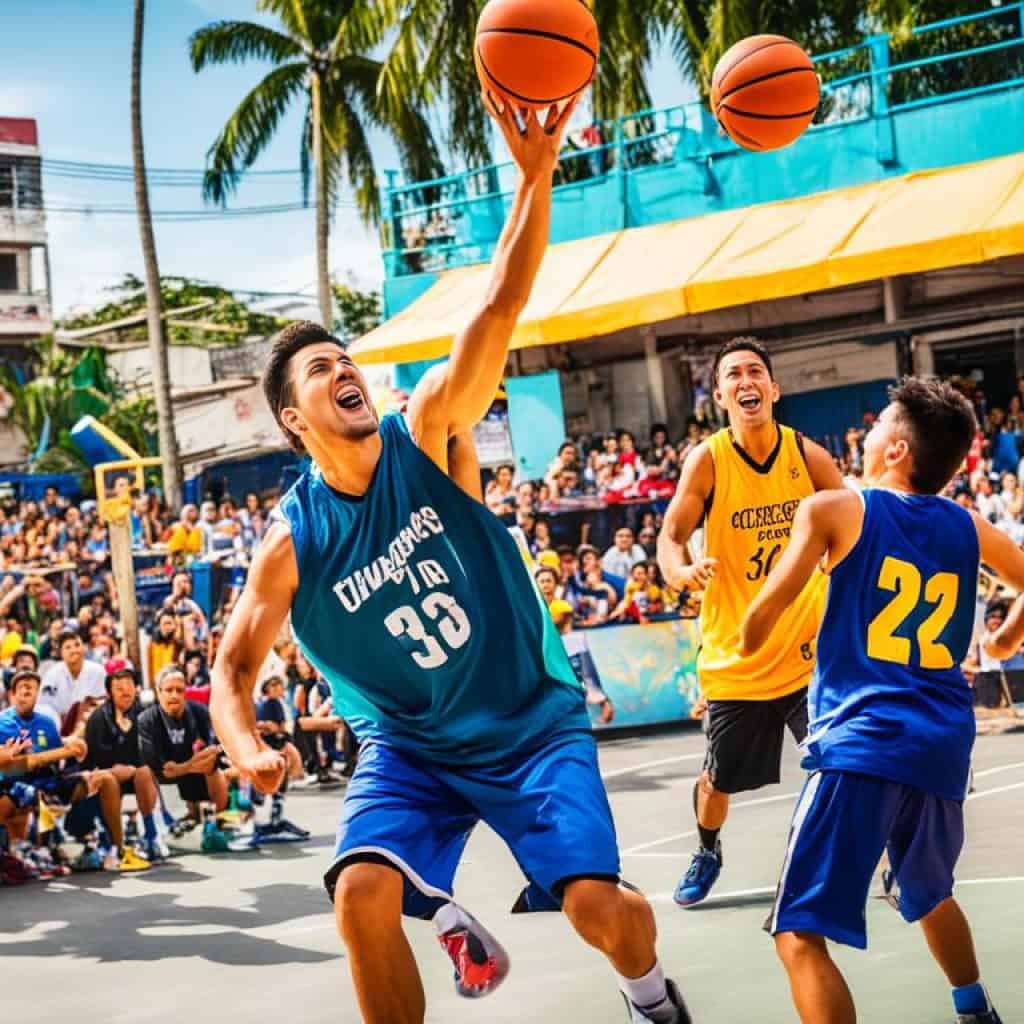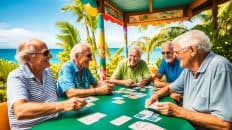Are you curious about what daily life looks like in the Philippines? Step into a world of warm hospitality, rich traditions, and mouthwatering cuisine as we delve into the unique Filipino lifestyle. From celebrating major life events as a community to savoring the flavors of adobo, the national dish, the Philippines offers a fascinating glimpse into a vibrant culture. So, what makes daily life in the Philippines so captivating? Let’s uncover the secrets and discover the beauty of Filipino cultural experiences.
Traditions and Customs in the Philippines
The Philippines is a country rich in cultural traditions and customs that have been passed down through generations. These traditions reflect the values and beliefs of the Filipino people and play a significant role in shaping their way of life.
One of the most important customs in Filipino culture is the emphasis on respect for elders. It is customary for younger individuals to show deference to older family members and community leaders. The use of honorifics like “po” and “opo” when addressing elders is a common practice, expressing politeness and demonstrating a deep-rooted sense of respect.
Family ties are another integral part of Filipino traditions. Family is considered the core unit of society, and maintaining strong family bonds is highly valued. Filipinos often prioritize spending time with their families, and extended family gatherings are common. Celebrating birthdays, anniversaries, and other special occasions together reinforces the importance of familial relationships.
“Family is not an important thing, it’s everything.” – Michael J. Fox
The concept of “Bayanihan” exemplifies the Filipino spirit of communal unity and cooperation. Bayanihan refers to the practice of coming together as a community to help a neighbor in need. This collaborative effort often involves physically moving a house or supporting a community project. The spirit of Bayanihan underscores the value Filipinos place on collective responsibility and helping others.
Fiestas are a prominent part of Filipino culture, showcasing the joyful and festive nature of the people. Fiestas are community celebrations held in honor of patron saints, and they bring together people from all walks of life. These lively festivals are marked by colorful parades, traditional dances, music, and delicious local cuisine.
Religious holidays hold significant importance in the Filipino calendar. Christmas and Easter are widely celebrated across the country, with religious processions, midnight masses, and festive gatherings. These holidays serve as opportunities for Filipinos to express their faith and strengthen their spiritual connections.
| Filipino Customs and Traditions | Description |
|---|---|
| Coming-of-Age Ceremonies | A celebration marking the transition of young individuals into adulthood, often accompanied by religious rituals and family gatherings. |
| Weddings | Filipino weddings are vibrant affairs that showcase the rich cultural heritage of the country. They involve various customs, such as the exchange of wedding coins and the release of doves as symbols of love and unity. |
| Panunuluyan | A tradition during Christmas wherein individuals reenact Mary and Joseph’s search for a place to stay, emphasizing the importance of hospitality and compassion. |
These traditions and customs provide a glimpse into the unique cultural identity of the Philippines. They emphasize the values of respect, unity, and faith that are cherished by Filipinos and contribute to the vibrant tapestry of Filipino culture.
Local Cuisine in the Philippines
Filipino cuisine is a delightful blend of Eastern and Western flavors, creating a culinary experience that is both unique and satisfying. In the Philippines, food is a central part of the culture, and locals take great pride in their traditional dishes.
Rice and fish are the staple foods in the Philippines, forming the foundation of many meals. However, Filipino cuisine offers a wide variety of dishes prepared using different cooking methods such as boiling, grilling, and stewing, resulting in an array of textures and flavors.
One of the most beloved Filipino dishes is adobo â a delightful combination of meat (usually chicken or pork) marinated in vinegar, soy sauce, garlic, and spices. Adobo is often considered the national dish of the Philippines and is cherished for its tangy and savory taste.
In addition to adobo, Filipino cuisine boasts other popular dishes that showcase the country’s rich culinary heritage. Sinigang, a sour soup made with tamarind and various vegetables, is beloved for its refreshing and tangy flavor. Lechon, a whole roasted pig cooked over an open fire, is a centerpiece at special occasions, and its crispy skin and succulent meat are truly irresistible. For dessert, halo-halo steals the show â a delightful mix of crushed ice, sweetened fruits, beans, and various toppings that provide a refreshing and satisfying treat.
Experience the richness of Filipino food and indulge in the unique flavors and textures that define local cuisine in the Philippines. From savory adobo to refreshing halo-halo, every bite is a celebration of Filipino culture and culinary creativity.
| Dish | Description |
|---|---|
| Adobo | A savory dish made with meat (usually chicken or pork) marinated in vinegar, soy sauce, garlic, and spices. |
| Sinigang | A sour soup made with tamarind, various vegetables, and meat or seafood. |
| Lechon | Whole roasted pig cooked over an open fire, known for its crispy skin and tender meat. |
| Halo-Halo | A dessert made with crushed ice, sweetened fruits, beans, and various toppings, offering a delightful mix of flavors and textures. |
Social Norms in the Philippines
In the vibrant and culturally rich country of the Philippines, social norms play a significant role in shaping interactions and relationships. These norms are deeply rooted in values such as respect, hospitality, and strong family bonds. Understanding and embracing Filipino social etiquette can lead to a deeper appreciation of the local culture. Here are some key social norms to keep in mind when navigating Filipino society:
Respect and Hospitality
Respect is highly valued in Filipino culture. When meeting someone, greeting them with a warm smile and addressing elders or people in positions of authority with “po” or “opo” (words denoting respect) is essential. Filipinos take pride in their hospitality and make visitors feel welcomed and valued. It is common for Filipinos to go out of their way to assist and accommodate others.
Physical Contact and Personal Space
Filipinos are generally comfortable with physical contact during interactions. Handshakes, hugs, and cheek kisses are common forms of greeting friends and family members. Personal space tends to be smaller compared to Western cultures, reflecting the close-knit nature of Filipino communities.
Filipino Time
‘Filipino Time’ refers to a more flexible approach to punctuality. While it is always best to be on time for formal events or business meetings, Filipinos are generally tolerant of slight delays and understand that unforeseen circumstances may sometimes cause lateness. It is advisable to communicate any delays promptly and politely.
Gift-Giving
Gift-giving is a significant aspect of Filipino culture, particularly during celebrations and special occasions. It is customary to bring small gifts when invited to someone’s home as a token of appreciation and goodwill. Common gifts include food, flowers, or small trinkets. The gesture of gift-giving strengthens social connections and fosters a sense of camaraderie.
“Respect is highly valued in Filipino culture. When meeting someone, greeting them with a warm smile and addressing elders or people in positions of authority with ‘po’ or ‘opo’ is essential.”

| Social Norms in the Philippines | Description |
|---|---|
| Respect and Hospitality | Showing respect to others and extending warm hospitality are highly valued in Filipino culture. Greeting others with a smile and using respectful language, such as “po” and “opo” when addressing elders, is crucial. |
| Physical Contact and Personal Space | Filipinos are comfortable with physical contact and have smaller personal space compared to Western cultures. Handshakes, hugs, and cheek kisses are common forms of greeting. |
| Filipino Time | Flexibility with punctuality is a social norm in the Philippines. While being on time is appreciated, slight delays are often tolerated, and open communication is key. |
| Gift-Giving | Gift-giving is a common practice and an essential way to strengthen social connections. Bringing small gifts to social gatherings and special occasions is customary. |
Must-See Places in the Philippines
The Philippines is a country blessed with stunning natural landscapes and a rich cultural heritage. From idyllic beaches to historical cities, there are countless must-see places that capture the beauty and diversity of this archipelago. Whether you’re a nature lover, history enthusiast, or simply seeking adventure, the Philippines has something to offer for everyone.
1. Boracay
Boracay is famous for its powdery white sand beaches and crystal-clear turquoise waters. With a vibrant nightlife, water sports activities, and luxurious resorts, it is a popular destination for both locals and tourists. Whether you prefer lounging on the beach or engaging in thrilling water activities such as snorkeling or island hopping, Boracay is a must-visit tropical paradise.
2. Palawan
Palawan is often hailed as one of the world’s most beautiful islands. It offers breathtaking landscapes, including the UNESCO World Heritage Site, the Underground River. The archipelago is also home to abundant marine life, making it a haven for diving and snorkeling enthusiasts. Don’t miss the stunning natural wonders of El Nido and Coron, where pristine beaches, limestone cliffs, and vibrant coral reefs await.
3. Banaue Rice Terraces
Experience the awe-inspiring beauty of the Banaue Rice Terraces, a UNESCO World Heritage Site. Marvel at the ingenious engineering of the Ifugao people, who carved these terraces into the mountainside over 2,000 years ago. The stunning landscape, cascading rice terraces, and vibrant greenery make this a must-see destination for nature lovers and those seeking cultural immersion.
4. Vigan
Step back in time and explore the historic city of Vigan. Known for its well-preserved Spanish colonial architecture, cobblestone streets, and horse-drawn carriages, Vigan offers a glimpse into the country’s colonial past. Take a leisurely stroll along Calle Crisologo, visit the ancestral homes turned museums, and savor traditional Filipino dishes for a truly immersive experience.
5. Manila
Explore the vibrant capital city of Manila, where old meets new. Discover historical landmarks such as Intramuros, the walled city built during the Spanish colonial period. Immerse yourself in the bustling atmosphere of Quiapo and Binondo, the city’s oldest Chinatown. Indulge in local cuisine, visit world-class museums, and experience the vibrant nightlife that Manila has to offer.
These are just a few of the must-see places in the Philippines. Other popular attractions include the enchanting Chocolate Hills in Bohol, the stunning Underground River in Puerto Princesa, and the majestic Mayon Volcano in Albay. Whether you’re seeking natural wonders, cultural experiences, or adventurous activities, the Philippines has it all. Embark on a memorable journey and discover the beauty of this tropical paradise.
Daily Routines in the Philippines
Daily routines in the Philippines provide a glimpse into the dynamic and vibrant Filipino lifestyle. From the bustling urban centers to the serene rural areas, Filipinos embrace a wide range of activities and rituals that shape their everyday lives.
Mornings: A Nutritious Start
Each day begins with a hearty breakfast, setting the tone for the day ahead. Traditional Filipino breakfast options include rice, bread, or noodles, paired with dishes such as tocino (sweet cured pork), tapa (marinated beef), or longganisa (Filipino sausages). This nourishing meal fuels Filipinos for their daily endeavors.
Diverse Daily Engagements
As the day progresses, Filipinos engage in various activities depending on their occupation and lifestyle. Some individuals head to work or school, maneuvering through the bustling streets and utilizing public transportation. Others may spend their days running errands, tending to household chores, or engaging in livelihood activities.
A Siesta After Lunch
Lunch is traditionally a significant meal in the Philippines, often enjoyed with family or colleagues. After a satisfying meal, some Filipinos observe the tradition of “siesta,” a short nap to recharge and refresh for the rest of the day. This practice reflects the importance placed on rest and balance in daily routines.
Evenings: Time for Connection
Evenings in the Philippines are often dedicated to spending time with loved ones. Family or friends gather for dinner, sharing home-cooked meals or exploring the vibrant local food scene. This cherished bonding time allows Filipinos to strengthen relationships and create lasting memories.
Recreational Activities
To unwind and indulge in their passions, Filipinos engage in various recreational activities during their free time. These activities can include playing basketball, a beloved sport in the Philippines, or pursuing hobbies such as singing, dancing, or playing musical instruments.
| Activity | Time |
|---|---|
| Breakfast | Morning |
| Work/School/Errands | Daytime |
| Siesta | Afternoon |
| Dinner and Family Time | Evening |
| Recreational Activities | Free Time |
Through their daily routines, Filipinos find fulfillment in the simple joys of life, nourishing their bodies, enjoying moments of rest, and fostering meaningful connections with others. Their routines serve as a reflection of the unique Filipino lifestyle, characterized by warmth, resilience, and a strong sense of community.
Cultural Experiences in the Philippines
Experience the vibrant and diverse culture of the Philippines through a variety of cultural activities and events. Immerse yourself in traditional festivals, explore historical sites, and interact with local communities to gain a deeper understanding of Filipino traditions and way of life.
Traditional Festivals
One of the best ways to experience Filipino culture is by attending traditional festivals. These festive celebrations showcase the rich cultural heritage of the country through colorful parades, lively performances, and local delicacies. The Sinulog Festival in Cebu and the Panagbenga Festival in Baguio are two of the most popular festivals in the Philippines. The Sinulog Festival pays homage to the Santo Niño (Child Jesus) with street dances and religious processions, while the Panagbenga Festival is a month-long flower festival featuring elaborate floats and street dancing.
Historical Sites
Delve into the Philippines’ colonial past by visiting historical sites that offer insights into its rich history. The walled city of Intramuros in Manila is a well-preserved Spanish colonial-era district that takes you back in time. Explore the cobblestone streets, visit historic churches, and walk along the city walls for a glimpse into the Philippines’ colonial heritage. Another must-visit destination is Vigan, a Spanish colonial town known for its well-preserved architecture, ancestral houses, and horse-drawn carriages.
Indigenous Communities
To truly immerse yourself in Filipino traditions and way of life, consider exploring indigenous communities and interacting with locals. These communities offer a unique opportunity to learn about traditional practices, arts, and crafts that have been preserved for generations. Engage in cultural activities such as weaving, pottery-making, or traditional dance performances. By supporting these communities, you contribute to the preservation of Filipino cultural heritage and help empower local artisans and communities.
“Attending traditional festivals, visiting historical sites, and exploring indigenous communities allow visitors to experience the vibrant cultural tapestry of the Philippines.”
Enhance your cultural experience in the Philippines by participating in these activities and embracing the warmth and hospitality of the Filipino people.
| Festival | Location | Date |
|---|---|---|
| Sinulog Festival | Cebu | Third Sunday of January |
| Panagbenga Festival | Baguio | February |
Transportation in the Philippines
Getting around in the Philippines can be an adventure due to the bustling public transport system. From buses to jeepneys, the country offers a variety of options for navigating its vibrant cities and scenic landscapes. Here’s a closer look at transportation in the Philippines:
Public Transport
Public transport in the Philippines is a popular choice for both locals and tourists. Buses, trains, and jeepneys are the primary modes of public transportation, providing affordable options for commuting within and between different cities. Jeepneys, in particular, are iconic and unique to the Philippines. These colorfully decorated converted jeeps serve as shared minibusses, connecting various neighborhoods and offering a glimpse into Filipino culture.
Inter-Island Travel
For those looking to explore the stunning islands of the Philippines, boats and ferries are common modes of transportation. Whether it’s hopping from one island to another or embarking on a scenic river cruise, these water vessels provide a picturesque way to experience the country’s natural beauty.
Taxis and Ride-Hailing Apps
For more convenience and flexibility, taxis and ride-hailing apps are readily available in urban areas. These options offer a more comfortable and private mode of transportation, allowing you to navigate the busy streets with ease.
Driving in the Philippines
If you prefer the freedom of driving yourself, renting a car or hiring a private driver is an option. However, it’s important to note that traffic in major cities can be congested, and road conditions in some areas may be challenging. Familiarize yourself with local driving regulations and be prepared for the unique challenges of navigating through bustling streets.
Transportation Tips
When using public transport or driving in the Philippines, here are a few tips to keep in mind:
- Be aware of peak hours to avoid heavy traffic.
- Follow local regulations and traffic rules.
- Keep valuable belongings secure while using public transport.
- Use ride-hailing apps for a convenient and safe transportation option.
| Public Transport | Pros | Cons |
|---|---|---|
| Buses | – Affordable – Extensive routes | – Can be crowded during peak hours |
| Jeepneys | – Unique cultural experience – Affordable fares | – Limited seating capacity |
| Boats and Ferries | – Scenic views – Access to remote islands | – Limited schedules |
| Taxis and Ride-Hailing Apps | – Convenient – Private transportation option | – Potential surge pricing during peak hours |
With its diverse options for transportation, the Philippines offers numerous ways to explore its beauty and immerse yourself in Filipino culture. Whether you choose to ride a colorful jeepney, take a ferry to a pristine island, or navigate the bustling city streets in a taxi, transportation in the Philippines adds to the excitement and adventure of your journey.
Education in the Philippines
Educational opportunities in the Philippines are primarily provided by a combination of public and private schools. While public schools offer free education, it is important to consider the varying quality of facilities, resources, and teaching. On the other hand, private schools often provide better amenities and a more comprehensive curriculum, albeit at a higher cost.
The primary languages of instruction are English and Filipino, ensuring a bilingual environment that prepares students for the global stage. The curriculum encompasses a wide range of subjects, including mathematics, science, social studies, and Filipino language and culture. This holistic approach to education enables students to acquire a well-rounded knowledge base.
Higher education institutions in the Philippines are renowned for their programs in medicine, engineering, business, and other fields. These institutions provide students with excellent opportunities to pursue their chosen career paths and gain practical experience through internships and hands-on learning.
Public vs. Private Education
When deciding between public and private education in the Philippines, families must consider their financial capabilities and educational priorities. The table below highlights the key differences between public and private schools:
| Public Schools | Private Schools |
|---|---|
| Free education | Higher cost |
| Limited facilities in some areas | Better amenities and resources |
| Curriculum follows national guidelines | Enhanced curriculum with additional programs |
| Large class sizes | Smaller class sizes |
| Teaching staff may have varying qualifications | Qualified and experienced teachers |
Healthcare in the Philippines
In the Philippines, healthcare is provided through a combination of public and private hospitals and clinics. Public healthcare facilities, funded by the government, offer more affordable services but may have limited resources. On the other hand, private healthcare facilities provide specialized treatments and higher quality care, albeit at a higher cost. The Filipino healthcare system boasts well-trained medical professionals, including doctors and nurses, who are dedicated to delivering excellent healthcare services.
One notable aspect of the Filipino healthcare system is medical tourism. The Philippines has become a popular destination for individuals seeking affordable yet high-quality medical treatment. With state-of-the-art facilities and highly skilled medical professionals, medical tourists from around the world choose the Philippines for a wide range of treatments, including cosmetic surgeries, dental procedures, and advanced medical interventions.
Health insurance plays a significant role in supporting healthcare expenses in the Philippines. One well-known health insurance provider is PhilHealth, which offers coverage and financial support for medical services. PhilHealth ensures that individuals have access to healthcare services when they need them, providing peace of mind and financial assistance in times of medical emergencies or routine healthcare needs.
Public vs. Private Healthcare in the Philippines
When it comes to choosing between public and private healthcare in the Philippines, individuals consider various factors such as cost, quality of care, and accessibility. While public healthcare facilities are more affordable, they may face challenges in terms of limited resources, long waiting times, and crowded hospitals. On the other hand, private healthcare facilities offer shorter wait times, access to specialized treatments, and a higher quality of care, but at a higher cost.
Despite the differences, both the public and private sectors play vital roles in meeting the healthcare needs of the Filipino population. The public sector focuses on providing essential healthcare services to a larger number of individuals, including those from low-income backgrounds. Meanwhile, the private sector caters to individuals who can afford more specialized and personalized care.
Key Features of the Filipino Healthcare System:
- Combination of public and private healthcare facilities
- Availability of affordable public healthcare services
- Accessibility to specialized treatments through private healthcare
- Well-trained medical professionals
- Growing medical tourism industry
- Health insurance coverage through providers like PhilHealth
Sports and Recreation in the Philippines
Sports and recreation hold a special place in Filipino culture, offering opportunities for physical activity, camaraderie, and entertainment. The Philippines has a diverse range of sports and recreational activities that cater to various interests. Whether you’re a fan of team sports or prefer outdoor adventures, there’s something for everyone in this vibrant country.
Popular Sports in the Philippines
Basketball reigns supreme as the most popular sport in the Philippines. From local communities to professional leagues, basketball is deeply embedded in Filipino culture. The passion for the game is palpable, with many Filipinos idolizing basketball superstars and participating in friendly neighborhood tournaments. Other popular sports in the Philippines include boxing, football, volleyball, and martial arts such as arnis and taekwondo.
“Basketball is more than just a sport in the Philippines. It’s a way of life.” – PBA player Robert Jaworski
| Sport | Description |
|---|---|
| Basketball | The undisputed top sport in the Philippines, with a massive fan following and regular tournaments at all levels. |
| Boxing | Filipino boxers like Manny Pacquiao have achieved international fame, putting the Philippines on the global boxing map. |
| Football | Although basketball dominates, football is gaining popularity, with grassroots programs and the Philippine Azkals national team making waves. |
| Volleyball | A favorite among Filipinos, both as a competitive sport and a casual pastime on the beautiful beaches of the Philippines. |
| Martial Arts | Arnis and taekwondo are traditional martial arts that reflect the Filipino fighting spirit and philosophy. |
The Philippines has proudly represented itself in various international sporting events, including the Olympic Games. Filipino athletes have made their mark in sports such as boxing, weightlifting, and swimming, bringing pride and recognition to the country.
Recreational Activities and Outdoor Adventures
With its abundant natural beauty, the Philippines offers numerous opportunities for outdoor activities and recreational adventures. Hiking enthusiasts can explore breathtaking trails, including the world-famous Mount Pulag and Mount Mayon. The country’s pristine beaches provide an ideal setting for swimming, snorkeling, diving, and surfing. Enjoying the clear waters, vibrant coral reefs, and stunning marine biodiversity is an experience like no other.

Additionally, outdoor enthusiasts can indulge in adventure sports such as ziplining, rock climbing, and whitewater rafting. For those seeking a more serene experience, island hopping and exploring hidden coves offer a tranquil escape.
Recreational activities and outdoor adventures in the Philippines offer a perfect blend of excitement and natural beauty, leaving visitors with unforgettable memories.
Whether you’re cheering on your favorite basketball team, testing your limits with adrenaline-pumping adventures, or simply enjoying the beauty of the Philippine islands, sports and recreation in the Philippines provide a vibrant and fulfilling experience.
Arts and Entertainment in the Philippines
The Philippines is a hub of artistic creativity and cultural expression. Filipino artists have made remarkable contributions to various art forms, including visual arts, music, theater, and literature. Through their immense talent and passion, they have shaped the vibrant arts and entertainment scene in the country.
In the realm of visual arts, Filipino painters, sculptors, and architects have left an indelible mark. From the intricate sculptures of Guillermo Tolentino to the vibrant paintings of Fernando Amorsolo, Filipino artists capture the essence of the Philippines in their works. The Philippine National Museum, home to countless masterpieces, proudly showcases the rich artistic heritage of the country.
Music is an integral part of Filipino culture, and it manifests in various forms, both traditional and contemporary. The Philippines is well-known for its folk music and dance traditions, with performances that resonate with the heartfelt emotions of the Filipino people. Large-scale concerts and music festivals provide platforms for local talents to showcase their skills and connect with audiences from around the world.
“Filipino artists have mastered the delicate art of storytelling through music and movement, transcending language barriers and stirring the souls of audiences worldwide.”
Theater enthusiasts can revel in the vibrant theater scene, where stage productions bring to life captivating stories and showcase the immense talent of Filipino actors, directors, and playwrights. Acclaimed theater companies such as Tanghalang Pilipino and Repertory Philippines stage diverse plays that range from classic adaptations to contemporary works.
Philippine literature is a treasure trove of narratives that reflect the Filipino experience. From the timeless works of national heroes Jose Rizal and Nick Joaquin to the modern novels of Jessica Hagedorn and Miguel Syjuco, Filipino writers have contributed significantly to the world of literature.
“Filipino literature depicts the struggles, aspirations, and triumphs of the Filipino spirit, offering readers a glimpse into the rich cultural tapestry of the Philippines.”
The film industry in the Philippines, often referred to as “Pinoy cinema,” has produced internationally acclaimed films that have captivated audiences worldwide. Directors such as Lino Brocka and Brillante Mendoza have garnered prestigious awards at film festivals, putting Philippine cinema on the global stage. The annual Metro Manila Film Festival, showcasing local films, has become a much-anticipated event for both filmmakers and audiences.
Here is a table showcasing some notable Filipino artists:
| Art Form | Notable Filipino Artists |
|---|---|
| Visual Arts | Fernando Amorsolo, Juan Luna, Ben Cabrera |
| Music | Lea Salonga, Ryan Cayabyab, Freddie Aguilar |
| Theater | Lea Salonga, Monique Wilson, Nonie Buencamino |
| Literature | Jose Rizal, Nick Joaquin, F. Sionil Jose |
| Film | Lav Diaz, Brillante Mendoza, Nora Aunor |
Filipino artists continue to shape the arts and entertainment scene in the Philippines, showcasing their creativity, talent, and the rich cultural heritage of the country.
Safety and Security in the Philippines
While the Philippines offers a warm and welcoming environment, it is essential to be aware of safety and security concerns. Certain areas, especially in urban centers, may have higher crime rates, and precautions should be taken to ensure personal safety. It is advisable to stay vigilant, avoid isolated areas, and take necessary precautions to protect personal belongings. It is also recommended to follow local laws and regulations and to seek advice from local authorities or trusted sources to ensure a safe and enjoyable stay in the Philippines.
In recent years, efforts have been made to improve safety and security in the country. The Philippine government has implemented various measures to combat crime and ensure the safety of both locals and tourists. The Philippine National Police (PNP) plays a crucial role in maintaining law and order and has increased its presence in areas with higher crime rates. Additionally, there are tourist assistance centers and hotlines available to provide information and assistance in case of emergencies.
While the overall crime rate has seen a decline in recent years, it is still advisable to exercise caution and remain aware of your surroundings. Petty theft, pickpocketing, and scams can occur in crowded areas and tourist spots, so it is essential to keep valuables secure and be cautious of your belongings.
“Safety and security should be a top priority for anyone visiting or residing in the Philippines. By staying aware, practicing good personal security habits, and seeking guidance from local authorities, individuals can mitigate potential risks and enjoy a pleasant experience in the country.” – Local Travel Expert
To further enhance your safety in the Philippines, here are some important tips and precautions:
Necessary Precautions for Personal Safety:
- Do not display or carry large amounts of cash or expensive belongings in public.
- Avoid walking alone at night, especially in less crowded or poorly lit areas.
- Use reputable taxi services or ride-hailing apps to ensure safe and reliable transportation.
- Be cautious when sharing personal information with strangers or on social media platforms.
Emergency Contacts:
In case of emergency or if you require assistance, here are some important contact numbers:
| Emergency Service | Contact Number |
|---|---|
| Police | 911 |
| Fire | 911 |
| Ambulance | 911 |
| Tourist Assistance and Protection Unit (TAPU) | +63 2 8591 1444 |
Conclusion
The daily life in the Philippines is a vibrant tapestry woven with strong family bonds, rich cultural traditions, and a delectable culinary heritage. From the breathtaking landscapes to the vibrant festivals, this Southeast Asian gem offers a multitude of experiences for visitors to immerse themselves in. While navigating through crowded public transport and considering safety precautions may pose minor challenges, the warm hospitality and unique cultural encounters make the Philippines an inviting destination.
Indulging in the mouthwatering Filipino cuisine is a highlight of daily life in the Philippines. From the iconic adobo to the refreshing halo-halo, the local flavors tantalize the taste buds and offer a window into the country’s diverse culinary landscape. This is complemented by a thriving arts and entertainment scene, where traditional performances and contemporary masterpieces captivate audiences and showcase the country’s cultural richness.
Embracing the Filipino way of life means embracing the strong sense of community, the celebration of family, and the warm nature of the people. Whether relaxing on the stunning beaches, exploring historic sites, or engaging in outdoor activities, visitors can discover the essence of daily life in the Philippines. Despite any challenges that may arise, the experiences gained from immersing in this vibrant culture are sure to leave a lasting impression and create memories to cherish.
FAQ
What is daily life like in the Philippines?
Daily life in the Philippines revolves around strong family bonds and extended family gatherings. It is characterized by vibrant culture, warm hospitality, and unique traditions and customs.
What are some traditions and customs in the Philippines?
The Philippines has a rich cultural heritage, with traditions and customs such as respect for elders, strong family ties, and the concept of “Bayanihan,” the Filipino spirit of communal unity and cooperation.
What is Filipino cuisine like?
Filipino cuisine is a fusion of Eastern and Western influences, with rice or rice noodles as the main staple. Popular dishes include adobo (marinated meat), sinigang (sour soup), lechon (roasted pig), and halo-halo (a dessert with crushed ice and sweetened fruits).
What are the social norms in the Philippines?
In the Philippines, social norms revolve around respect, hospitality, and strong family values. Greeting others with a smile, addressing elders with “po” and “opo,” and gift-giving during celebrations are common practices.
What are some must-see places in the Philippines?
Some must-see places in the Philippines include Boracay and Palawan beaches, the Banaue rice terraces, the historic city of Vigan, and the capital city of Manila. Other attractions include the Chocolate Hills, the Underground River, and the Mayon Volcano.
What are the daily routines in the Philippines?
Daily routines in the Philippines vary depending on location and occupation. Mornings typically start with breakfast, followed by work or school activities. Lunch is a significant meal, and evenings are often spent with family or friends.
What are some cultural experiences in the Philippines?
Cultural experiences in the Philippines include attending traditional festivals, visiting historical sites, and exploring indigenous communities. These activities provide insights into Filipino traditions, art forms, and way of life.
What is transportation like in the Philippines?
Getting around in the Philippines can be challenging due to crowded public transport. Options include buses, trains, jeepneys, and boats. Ride-hailing apps are also available for added convenience.
What is the education system like in the Philippines?
The education system in the Philippines consists of both public and private schools. Public schools provide free education, while private schools offer better facilities and resources. English and Filipino are the primary languages of instruction.
What is the healthcare system like in the Philippines?
The healthcare system in the Philippines includes both public and private hospitals and clinics. Public healthcare is more affordable but may have limited resources, while private healthcare offers specialized services at a higher cost.
What are some popular sports and recreational activities in the Philippines?
Basketball is the most popular sport in the Philippines. Other popular sports include boxing, football, volleyball, and martial arts. Outdoor activities such as hiking, diving, and surfing are also enjoyed due to the country’s natural beauty.
What is the arts and entertainment scene like in the Philippines?
The Philippines has a vibrant arts and entertainment scene, with talented artists contributing to various art forms. Traditional and contemporary dance performances, music concerts, and films showcase Filipino culture. Cultural institutions, museums, and theaters promote and preserve Filipino arts and culture.
Is the Philippines a safe country to visit?
While the Philippines offers a warm and welcoming environment, it is important to be aware of safety and security concerns. Certain areas may have higher crime rates, and precautions should be taken to ensure personal safety. It is recommended to stay vigilant and follow local laws and regulations.


















Add comment